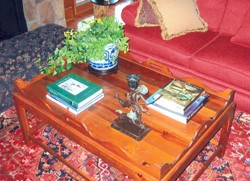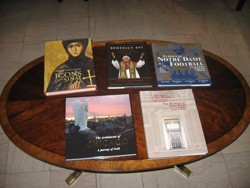Despite its generally unassuming presence in a living room, the coffee table is the one piece of furniture that can singularly scream personality—in the form of “I love contemporary pieces!” or “I’m a workaholic!”—the loudest. Both the table itself and the items upon it can communicate to others who you are and what priorities you hold. That untouched copy of War and Peace might clue in a visitor both to your ambitious literary preferences and your busy work schedule!
Many of today’s interior design strategies are focused on showcasing both style and aspirations, and the coffee table is no exception. In that light, we decided to showcase some personal coffee tables owned by well-known, successful Peorians and—with the help of local psychotherapist Dr. Joy Miller—try to decipher the personalities they were communicating. Unaware of their owners, Miller offered up her best insights. Right or wrong, we saw some beautiful, interesting tables and learned something along the way. We’re betting our copy of War and Peace that you will, too.
Down to Earth
 When she reviewed our first table, Dr. Miller spied the Harley Davidson booklet and pegged the owner as an adventurer. “But (the booklet) is nestled on top of a business connection magazine, (which is the) realist personality,” Miller said. “A playful sort—see that colorful remote? And he still tries to keep up with current environmental issues—his National Geographic.” The more you pour on the color, the more playful your personality probably is, Miller said.
When she reviewed our first table, Dr. Miller spied the Harley Davidson booklet and pegged the owner as an adventurer. “But (the booklet) is nestled on top of a business connection magazine, (which is the) realist personality,” Miller said. “A playful sort—see that colorful remote? And he still tries to keep up with current environmental issues—his National Geographic.” The more you pour on the color, the more playful your personality probably is, Miller said.
She then pointed out a book that looked untouched, To Kill a Mockingbird. “Perhaps a person who would really like to read the classics, but it’s difficult to find the time?” Miller suggested. But we know that Mayor Jim Ardis was hoping to catch up on the 2007 Peoria Reads! selection at home. Owning a minimalist or simple, no-frills coffee table like the Mayor’s suggests someone who is down to earth with few barriers, Miller said. “They are not caught up in impressing people with their status or wealth.”
Top This
What does the placement of objects on your coffee table say about you? “It’s interesting how things change when people believe they might be evaluated in some way,” Miller said. When you arrange your books or magazines, take a look at what subject matter you’re putting the focus on for your guests. Miller says the arrangement may shed some light on your career or highlight your true passion—such as Mayor Ardis’ placement of the City Council agenda or the Lincoln book in the picture below.
 Balance and Beauty
Balance and Beauty
Looking at this table, Dr. Miller believed that balance and beauty take priority in the owner’s life. “A collector of memories, this person loves adventures but also values family greatly,” Miller said. “My guess would be that this person loves for things to be organized and that the owner may be an in-charge kind of person. Everything has a place, and this person appears to be meticulous in his or her life journey.” An “in-charge kind of person”—few would argue with that description of Congressman Ray LaHood!

An Earthy Feel
This table exudes an earthy feel and characterizes the owner as a lover of nature. The book about France resting on the table could also depict an appreciation for the magnificence of far-away places. “The casual appearance of the table suggests this person is good with people, warm-hearted and focused on relationships versus trying to impress,” Miller said. Many who know former mayor Bud Grieves would agree with her assessment.
 Beliefs and Values
Beliefs and Values
Coffee tables can also tell a story of beliefs and values. “The bringing together of the lessons from the past, the present and the future weigh heavily on this owner,” Miller mused. “And center stage on the table, the focus is on the present and the strong commitment of the owner to his or her religious convictions. This owner is concerned with finding “balance” in all decisions in his inner life.
“But there is a playful side who loves fellowship and competitive play, as illustrated by the Notre Dame football book,” Miller added, bringing to light the passions of Bishop Daniel Jenky.
Just Your Type
The design of a coffee table also shares part of the story of your personality. You might swoon over a newer, contemporary coffee table, which could be constructed of any material—wood, metal or glass, according to Ben Bladel, a 25-year interior designer at Lippmann’s Furniture & Interiors. Or you may opt instead for an antique model like the baroque, ornately-carved table above.
 “This table seems to speak for itself,” Miller said. “Obviously, this is a person who is humbled by beauty and quality, and the owner may allow his or her actions to speak for themselves. This person’s motto might be that actions and behaviors of the individual speak louder than words.” Drawn to its history and character, our own Jonathan Wright went out of his way to purchase this hand-carved table at an antique shop in Sandwich, Ill. According to the store owner, a World War II serviceman fell in love with the table in Hong Kong and had it shipped home.
“This table seems to speak for itself,” Miller said. “Obviously, this is a person who is humbled by beauty and quality, and the owner may allow his or her actions to speak for themselves. This person’s motto might be that actions and behaviors of the individual speak louder than words.” Drawn to its history and character, our own Jonathan Wright went out of his way to purchase this hand-carved table at an antique shop in Sandwich, Ill. According to the store owner, a World War II serviceman fell in love with the table in Hong Kong and had it shipped home.
 A Pristine Environment
A Pristine Environment
The uniqueness of the base of this table could imply that its owner loves to be different, explained Miller. “The glass tabletop makes me believe the owner is confident in his or her ability to maintain a pristine environment,” Miller said. “I’m guessing this person might be a first child or someone who is overly responsible…and loves to have references at their fingertips.” Another former Peoria mayor, Dave Ransburg is most definitely responsible, and he was the oldest child in his family.
Evolving to Fit Function
Coffee tables didn’t take hold in America until the late 19th century. The concept originated in Europe in the 17th century with tea tables, a then-popular furniture item. Generally rectangular in shape and much taller than present-day coffee tables, tea tables would rest against high-backed sofas. It wasn’t until late in the Victorian era when the first “coffee tables” appeared—much lower and wider versions of the tea table. They were mass-produced in the U.S. in the 19th and 20th centuries, becoming increasingly affordable to the average American.
As our use of coffee tables has changed, so has their design. The clunky coffee tables of the 1970s and ’80s have been replaced by sleeker, more distinctive versions. According to Bladel, the average height of a coffee table twenty-five years ago was around 16 to 17 inches, but many coffee tables now hover between 20 and 22 inches. “Instead of holding a now-extinct ashtray and magazines, people do their work or eat dinner (on their coffee tables),” Bladel said. “They’re multi-purpose and have evolved to changing lifestyles.”
Coffee tables of the past often tried to blend in or match existing furniture; now they are larger and more detailed. “The days of the end tables and the coffee table being from the same collection are pretty much passé,” Bladel said. “If you can change your wall color and add a new coffee table, it makes the whole room look different. Little changes like that have a lot of decorating impact for not a huge expenditure of money.” Don’t be afraid to experiment with color, design and coffee table toppers; they’ll only add more personality to your room. a&s


 If you’re looking for a dash of whimsy, check out The Frenchman by Philippe Halsman. This quirky 1948 picture interview captures the weathered mug of French actor Fernandel in various comical expressions. For a more picturesque theme, pick up Annie Leibovitz’s A Photographer’s Life: 1990-2005, which includes many of her famous portraits of celebrities, musicians, artists and presidents.
If you’re looking for a dash of whimsy, check out The Frenchman by Philippe Halsman. This quirky 1948 picture interview captures the weathered mug of French actor Fernandel in various comical expressions. For a more picturesque theme, pick up Annie Leibovitz’s A Photographer’s Life: 1990-2005, which includes many of her famous portraits of celebrities, musicians, artists and presidents. 